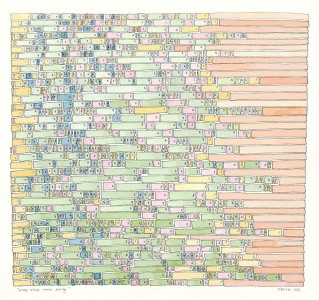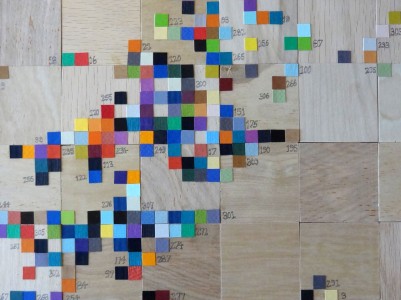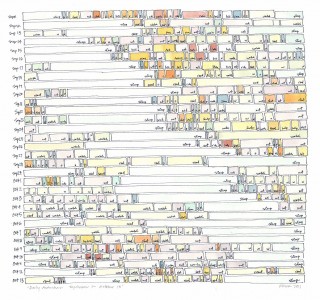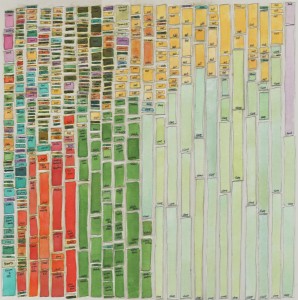Experiments in self-tracking - article in Second Sight
/I met Paul at the Quantified-Self conference last year, and he asked to write an article for Second-Sight in the Netherlands, both a blog and a physical magazine, with a genuine transhumanist orientation....as my friend Adam Curry likes to call me ;-). It captures a little history of the Quantified-Self and sweetly summarizes my Ted talk, and makes a nice post. Thanks Paul! Laurie Frick - Experiments in self tracking | Article in Second Sight magazine June 2013 issue - Paul van den Bosch
Wouldn't you like to get to know yourself better? Laurie Frick does, so she collects metrics of herself and creates hand-built works and installations with beautiful patterns and colorful rhythms. Inspired by neuroscience she uses her work to get a deeper understanding of the nature of pattern and the mind.
As a former executive of a high tech company with a background in high technology and engineering she is no stranger to numbers. After she retired early, 10 years ago, she started a new career, this time as an artist. She now spends most of her time in Austin (Texas) and New York and has been awarded various residencies including one by the UT Neuroscience Imaging Research Center.
Frick became interested in the notion of little bits of time and why we jump from one thing to the next, so she began trying to capture a little diary of how she spent her time. She soon realized it was incredibly difficult to do, so she started measuring her sleep cycles as an easier way to measure how she spent her sleep.
Simultaneously she found Ben Lipkowitz who measured how he spent his minute-by-minute time for the past seven years. At first he just wondered how much time he needed doing the dishes, but this simple measurement evolved into an incredible life-logging project. In Frick’s words “demonstrating the subliminal, underlying metrics of a person, all these measurements became like a data portrait measured and captured of you”. This is how she got involved in the Quantified Self movement. The "Living by Numbers" movement was originally started by Gary Wolf and Kevin Kelly, editors of Wired Magazine. They noticed that a lot of people were measuring certain aspects of their life and thanks to the increased availability of wearable sensors, combined with wearable computing and wireless communication were collecting data about themselves, creating visualizations and looking for meaning in these numbers. People started to meet, explaining what and how they measured themselves.
Currently more than 100 Quantified Self groups exist all over the world. Self tracking has become popular and many devices are available. People use activity trackers such as the Fitbit or Nike+ Fuelband, hook themselves up to sleep monitors, perform biometric measurements, monitor their blood glucose and food intake, and even have their genetic profile mapped. Tracking yourself is no longer limited to making sure you don’t weigh to much, but is becoming a means to learn more about yourself and to collect detailed, objective information about your health.
 Frick started to measure her life in great detail; she recorded how she slept, kept a log of her walking and travel patterns, measured her heart rate, collected speech patterns, made notes of the food she ate, how much time she spent online, and more. Being an artist she then started to work with all these data, trying to make sense of them in a visual way. It is interesting to see how she works, for example how she processed her sleep data into a work of art. She started by measuring her sleep using a Zeo, a device with a headband that measures your EEG and records the sleep state you’re in. She exported the sleep data into an excel sheet and used colors to represent each sleep state. Using these as a starting point she made lots of drawings. She then collected all kinds of pieces of wood that she used to create the final artworks.
Frick started to measure her life in great detail; she recorded how she slept, kept a log of her walking and travel patterns, measured her heart rate, collected speech patterns, made notes of the food she ate, how much time she spent online, and more. Being an artist she then started to work with all these data, trying to make sense of them in a visual way. It is interesting to see how she works, for example how she processed her sleep data into a work of art. She started by measuring her sleep using a Zeo, a device with a headband that measures your EEG and records the sleep state you’re in. She exported the sleep data into an excel sheet and used colors to represent each sleep state. Using these as a starting point she made lots of drawings. She then collected all kinds of pieces of wood that she used to create the final artworks.
The one feature that stands out in her work are the recurring patterns: her idea is that innate patterns of behavior and body function are like an individual fingerprint. Literally everything you start to imagine that can be measured creates a portrait of you. You have an individual rhythm that’s particular to you and it can also reflect who you are. She discovered for example that her sleep patterns are pretty steady. She has a very low standard deviation of her sleep score, versus her husband whose sleep score swings wildly. She realized it was a reflection of both their personalities.
Laurie Frick thinks self-tracking will become invisible, embedded into apps that we use and don’t even think about. Self-tracking data will be pervasive, for example our clothes will have sensors that know how much we moved our arms and legs, and thus will send accurate data about our caloric expenditure to our Fitbit or Nike+ Fuelband dashboard. Our watch will track our heart-ratevariability and give us little stress alerts. Laurie Frick's best fantasy is that all our data will be turned into a patterned wall texture that is spit out from a 3D printer in the walls of our home. It will be recyclable and updatable, giving us feedback about our activities and the changes in our body, allowing us to adjust your behavior and tweak our daily habits. “We will create human data portraits as art on our walls: mindfulness made tangible".
When asked if she thinks her artwork could be a source of inspiration for science, she replies she doesn’t want to presume an artist could have an effect on scientific research. But she mentions an interesting subject. It seems that the work on the human Connectome project to map the pattern of connections in the brain might find there is an innate pattern of you. It’s a rhythm that is inherently familiar and repeats itself in many facets of the person you are. And strangely enough there is a resonance when you encounter those same patterns in the real world. Frick’s art give us an intimate look into her own patterns.
She also thinks big data research teams can learn from artists on how to deliver data that is addictive, beautiful and something you want to look at. Much of the self-tracking data graphics is so literal and dull, that it is hard for the average person to discover any meaning in all those data points. How do you for example determine the relationship between your mood, your physical location and the time of day? But if the visual presentation of data were to be artified, it would make it a lot easier to understand.
Even if science isn't inspired by art Frick’s work shows that art can teach us about ourselves, just as science does. Frick's art reveals a person's innermost patterns and maybe one day we will be gazing at the walls of our living room looking at these beautiful patterns, and gain a deeper understanding of who we are.
Will our 'digital social pulse' diagnose and predict our behaviour?
/Was struck by the phrase 'Digital Social Pulse' from Deborah Estrin at TEDMED last week, chatted with her and the Open mHealth initiative, working to fix the data API problem with a clean standard. But mostly she reinforced this idea about the data of YOU having diagnostic and predictive ability. That coupled with a request also last week from a public spaces project asking for a super short public art proposal, I thought about how we can use both data collected about us, with data collected in a neighborhood and begin to build a narrative....a story that helps us understand ourselves and the places we live.

Our ‘digital social pulse’ will be the way we live and how we move through the world. Imagine when city streets will be both smart and how we discover and understand more about ourselves. It’ll be fun. It will be beautiful. It will support our need as humans to feel apart of our community.
Connect self-tracking data gathered from GPS and accelerometers on our phone, fitbit devices, fuelbands, watch sensors with crowd-sourced proximity data gathered in the downtown neighborhood to accumulate and build a narrative story about how people walk, shop, eat, drive and encounter random experiences in an urban neighborhood.
Connect the small-data of you, your digital social pulse with how an urban downtown functions as a social space.
Draw people into repetitive experiences where their presence builds and adds to the narrative of the downtown street-scene. Lure them toward experiences with small curious installations to alter their normal path. Offer a visible method for pedestrians and riders to signal on their phone when they are contributing. Allow people to learn something new about their patterns and see something about themselves they wouldn't normally notice. Delight and surprise. Combine the digital with the physical.
We move through spaces and sense the scale of human proportions, distance and space. We move in close when something grabs our attention and unconsciously walk toward it. Chance conversations can shift our mood. Something bright and shiny in the distance can shift our path and pull us toward it.
 My focus in the past year has been tracking movement and travel by walking and photo gathering through a city. I’m using a fitbit and Basis watch which tracks steps, temperature and pulse. Openpaths, which gathers time and GPS coordinates. I often supplement with time-lapse photography using a little camera I wear around my neck to document the visual experience. The art installation pieces use underlying algorithms – as I experiment with ways to use weather, color, sense and data to build human data portraits from patterns of behaviour.
My focus in the past year has been tracking movement and travel by walking and photo gathering through a city. I’m using a fitbit and Basis watch which tracks steps, temperature and pulse. Openpaths, which gathers time and GPS coordinates. I often supplement with time-lapse photography using a little camera I wear around my neck to document the visual experience. The art installation pieces use underlying algorithms – as I experiment with ways to use weather, color, sense and data to build human data portraits from patterns of behaviour.
Every time I look at future scenarios of data tracking – it takes on a hugely sinister theme. Intense fear, worry, anxiety, loss of privacy to government agencies or global brand advertisers is the typical response. At times I think it is inevitable. Every bit of data about us will be known. Should we worry, or can we personally begin to know more and self-experiment. Rather than just be fearful, we might grab even more data and play with it, test it out, experiment with how it feels and build something we desire and embrace.
So, in anticipation of a time where total surveillance is normal, sensors are seamlessly embedded in our clothes and in tiny bits we swallow with vitamins. Location coordinates are gathered from phones and recordings of what we see, say and hear are invisibly captured, I've been collecting data to experiment and test ways of converting data into abstract patterns which can communicate encoded meaning about us and how we live in the neighborhoods we love.
There is an opportunity to connect the data we gather about ourselves and marry it with the data collected about how we live and move thru a downtown neighborhood. There is a story that can be created and the combination can be illuminating.
5 questions
/5 questions from Paul van den Bosch who writes for Second Sight blog in the Netherlands 1. Why are you so interested in measuring yourself?
I was interested in the notion of little bits of time, and why we jump from one thing to the next and began trying to capture a little diary of how I spent my time. And realized its unbelievably difficult. I started measuring my sleep cycles as an easier…almost automatic way to measure how I spent my sleep (and yes, it’s all little 5 and 10 minute bits of time), and simultaneously found Ben Lipkowitz online who measured how he spent his minute-by-minute time for the past 7 years. Was curious about the subliminal, underlying metrics of a person. Like a data portrait measured and captured of you.
2. In your TEDtalk you talked about data patterns helping to understand ourselves: have you already discovered things about yourself? And was that after you analyzed the data or after you created your artworks?
My idea is that innate patterns of behaviour and body function are like an individual fingerprint. Your heart rate, sleep patterns, walking and travel patterns, speech patterns, food you eat…literally everything you start to imagine that can be measured creates a portrait of you. You have an individual rhythm that’s particular to you and can also be a reflection of your personality. For example, my sleep patterns are pretty steady, I have a very low standard deviation of my sleep score, versus my husband whose sleep score swings wildly. I realized it was a reflection of both our personalities.
My process is to analyze and create, analyze and create, test something, throw it away, do it again, analyze and create….you get it.
3. How do you see the future of Quantified Self / measuring ourselves; for example do you think that measuring ourselves will become common? Will everybody then become a data analyst, peering over his spreadsheets and dashboards, trying to make sense of all these data?
I think self-tracking will become invisible, and embedded into apps that we use and don’t even think about. No, we won’t pour over spreadsheets, but self-tracking data will be pervasive… for example - our clothes will have sensors that know how much we moved our arms and legs, and thus will send accurate data about our caloric expenditure to our Fitbit or fuelband dashboard. Our watch will track our heart-rate-variability and give us little stress alerts. And my best fantasy is that all our data is turned into patterned wall texture that is spit out from a 3D printer in the walls of our home. Recyclable, updatable. Human data portraits as art on our walls….mindfulness made tangible.
4. What would you like to measure / investigate, that is currently not possible?
It is incredibly hard to accurately and easily track what you eat. The nutrition, the content and make-up of what you consume would be fantastic to track automatically. I want it to be as easy as how I capture my weight, fat and BMI by just stepping on my wifi scale.
5. Do you think science can learn from / be inspired by (your) art?
Massive braggadocio to think an artist has an effect on scientific research….but here’s my thought. It seems like the work on the human Connectome project to map the pattern of connections in the brain might find there is an innate pattern of you. And it’s a rhythm that is inherently familiar, and repeats itself in many facets of you. And weirdly there is an resonance when you encounter those same patterns in the real world.
I do think big-data research teams can learn from artists on how to deliver data that is addictive, beautiful and something you WANT to look at. Much of the self-tracking data graphics is so literal and dull, they need to ARTIFY the visual presentation of data. Come talk to me ;-).
Artify...will we talk about artification - same as we talk about gamification?
/We'll talk about ARTIFY the same way we talk about GAMIFY today...a way to make something addictive.

Art is a lens to think about, stop and examine an experience. It gets you to feel something and really stop and consider. Sometimes you think about it over and over and roll it around in your head for days or months afterward.
I predict we'll see phone apps (applications and usage on smart phones) begin to incorporate metaphor and artification of data and information to pull you into repetitive use. It's not about designing a more beautiful interface, but it's about presenting data and information in a way that gets you to see it anew. I think self-tracking data for weight, sleep, walking, running, heart-rate....and all the new body sensors will find ways to artify the data - so you can easily see patterns in your behaviour to anticipate and gain insight to you.





